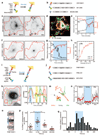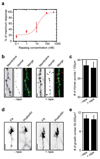Optogenetic control of organelle transport and positioning
- PMID: 25561173
- PMCID: PMC5063096
- DOI: 10.1038/nature14128
Optogenetic control of organelle transport and positioning
Abstract
Proper positioning of organelles by cytoskeleton-based motor proteins underlies cellular events such as signalling, polarization and growth. For many organelles, however, the precise connection between position and function has remained unclear, because strategies to control intracellular organelle positioning with spatiotemporal precision are lacking. Here we establish optical control of intracellular transport by using light-sensitive heterodimerization to recruit specific cytoskeletal motor proteins (kinesin, dynein or myosin) to selected cargoes. We demonstrate that the motility of peroxisomes, recycling endosomes and mitochondria can be locally and repeatedly induced or stopped, allowing rapid organelle repositioning. We applied this approach in primary rat hippocampal neurons to test how local positioning of recycling endosomes contributes to axon outgrowth and found that dynein-driven removal of endosomes from axonal growth cones reversibly suppressed axon growth, whereas kinesin-driven endosome enrichment enhanced growth. Our strategy for optogenetic control of organelle positioning will be widely applicable to explore site-specific organelle functions in different model systems.
Conflict of interest statement
The authors declare no competing financial interests.
Figures












Comment in
-
Cell biology: Organelles under light control.Nature. 2015 Feb 5;518(7537):41-2. doi: 10.1038/nature14086. Epub 2015 Jan 7. Nature. 2015. PMID: 25561179 No abstract available.
-
Organelle dynamics: Organelles under the spotlight.Nat Rev Mol Cell Biol. 2015 Mar;16(3):126-7. doi: 10.1038/nrm3944. Epub 2015 Jan 21. Nat Rev Mol Cell Biol. 2015. PMID: 25604200 No abstract available.
References
Publication types
MeSH terms
Substances
Grants and funding
LinkOut - more resources
Full Text Sources
Other Literature Sources
Research Materials

